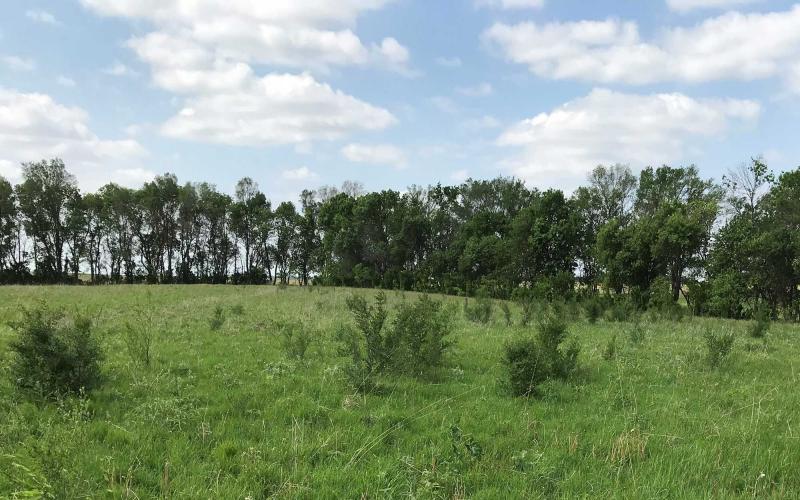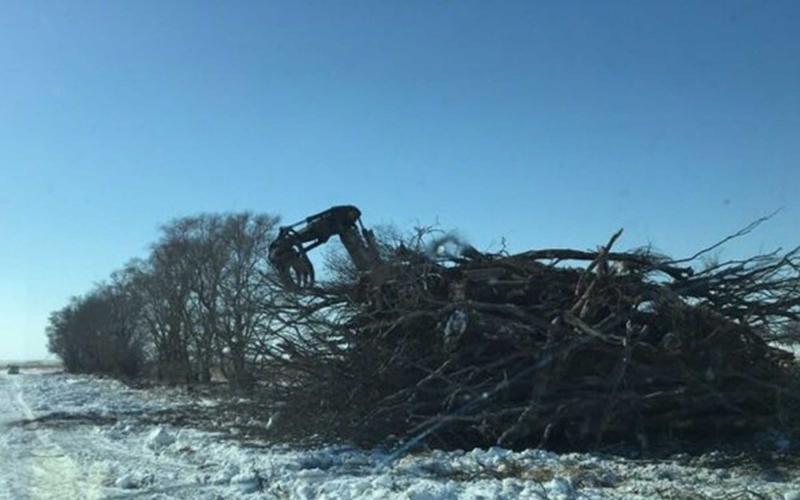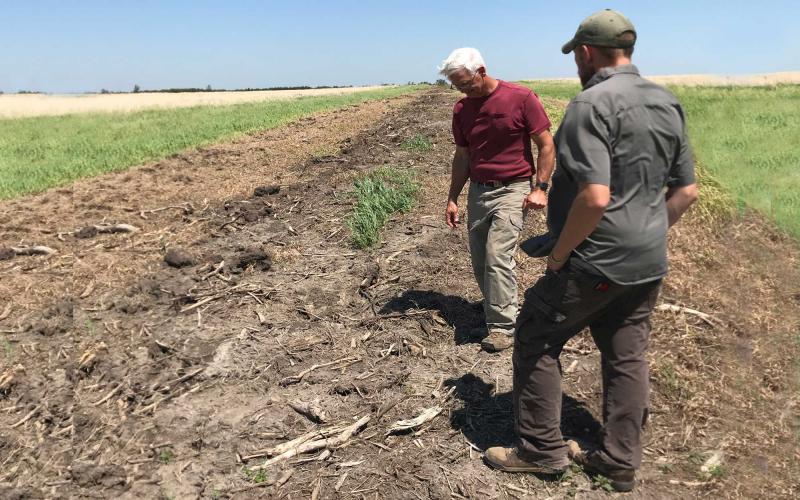
Written collaboratively by Pete Bauman and Brian Pauly.
Shelterbelts and tree claims were initially established in this region during the homestead act as a source of shelter, fuel, and economic benefit to those settling the area. Since that time, additional shelterbelts of a variety of shapes and sizes have been added to the landscape. Primarily, these shelterbelts were installed to protect exposed agricultural soils from wind erosion. Shelterbelts can be comprised of a variety of species, but common to many shelterbelts in our area are species such as eastern redcedar, green ash, Russian olive, crab apple, and Siberian elm. Trends in farming practices over the last several decades have resulted in the removal of many shelterbelts from agricultural areas and old homesteads, often to the dismay of those interested in soil and wildlife conservation.
Shelterbelt establishment for wildlife cover remains a common practice supported by several agencies, and the science of shelterbelt design and establishment often calls for different species of trees and shrubs depending on the goals and objectives of the wildlife project. However, in some instances, sound wildlife management calls for the removal of shelterbelts as a conservation tool and removing mature and established shelterbelts from the landscape can be a very controversial management decision.
Why remove shelterbelts in grasslands?

Under what circumstances would removal of mature shelterbelts be warranted? This is a common question often asked in wildlife and conservation circles. In actuality, most mature shelterbelts in grasslands are actually remnants from when those areas were actively farmed and were not designed well to serve grassland species, even if the crop fields were returned to grassland cover.
There are three primary drivers that warrant substantial consideration when evaluating the need to remove or forego planting a shelterbelt for wildlife or conservation purposes related to grassland communities. Research has shown that shelterbelts can serve as perch sites for aerial predators, such as raptors. These perch sites have a sphere of impact around them that can extend for several hundred yards and can be detrimental to grassland birds. Shelterbelts, scattered large volunteer trees, and even lone trees in a grassland system (known as ‘wolf’ trees) can serve to impact the grassland wildlife community through predation by raptors and others. Perhaps as significantly as perch sites for predators is the effect of shelterbelts as ‘highways’ for predators, offering both escape cover and den sites for common ground predators such as skunks, raccoons, feral cats, and others. Finally, shelterbelts can be a source of invasive plant species that can compromise the health of the adjacent grasslands or pastures. Not only can shelterbelts harbor invasive weedy species, they are a primary source of windblown tree seeds moving out into the grasslands (Figure 1 and Figure 2).
How can large shelterbelts be removed?

Large shelterbelt removal often requires significant effort and mechanical resources. Removal of small or isolated shelterbelts can be accomplished with smaller equipment found on most farms such as chainsaws and tractors or skid steers. When removing larger trees with chainsaws and on-farm equipment, care should be taken to cut trees as low as possible and to treat stumps with appropriate re-growth inhibiting chemical, such as Garlon®. Cutting has some limited benefits as it is less disruptive of the soil, but future treatments of volunteer trees and re-sprouts is a common occurrence and often requires continued maintenance of the site with chemicals and/or mowing. Eventually, these shelterbelts can be re-seeded with grass species via broadcasting seed, but results can be variable. It should be noted that many old shelterbelts have a variety of tree species in various states of health and structural integrity. Cutting trees should only be attempted by experienced and well-trained sawyers with all personal protective equipment in place and properly utilized.
A second and more practical option for shelterbelt removal is to employ contractors with the correct equipment to handle large trees Skilled operators can often pull large trees up by the roots, removing the root ball and tree as a single unit. Often much of the soil in the root ball can be shaken loose for further processing of the trees. This and other mechanical removal methods results in considerable ground disturbance and often require some level of cleanup of remaining roots, branches, and other trash. These sites also often require additional future maintenance such as soil leveling and chemical or mechanical control of re-growth, volunteer trees, and weeds prior to establishing grass (Figure 3).
Piling, burning, and burying, burning?
When removing shelterbelts, a common practice is to pile the trees for future disposal. Often, the intent is to allow the piles to dry for a period of time before burning. While this can be effective, most piles fail to burn down well. One method that works well is to burn trees immediately as they are removed while green leaves are still intact. Experience has shown that if burned immediately while the process of removal is occurring, the trees burn down very well, leaving very little residue. Seek out contractors who have experience using this method of ‘green burning’, as removal of soil from root balls and pile arrangement and management are keys to successful green burning. Burning tree piles near existing grasslands requires planning. Piles should be surrounded by ample exposed soil with a large buffer from standing grasslands. Avoid extremely hot, windy, or volatile conditions. Follow all local ordinances related to open burning and be sure to monitor the pile until certain the burn is complete.
Regardless of when and how the trees are initially processed, it is commonly necessary to bury at least some of the remains. Again, larger track hoes or similar equipment can easily accomplish this task. Sites with buried remains should be monitored for settling over time as material degrades and may require additional maintenance if a large amount of material is buried.
Cost share or other assistance programs for grassland shelterbelt removal.

Removing mature shelterbelts from new or established grasslands can be a very positive action for desirable wildlife such as upland birds and waterfowl. However, removal often requires a large investment in equipment, labor, or both. Just as some agencies provide cost share for establishing wildlife-appropriate shelterbelts, often coaching and cost share is also available for removal of old crop field shelterbelts when establishing grassland project (See local conservation agency representatives for more details on possible cost share programs, Figure 4).
Additional Resources
- Bakker, KK. 2006. The Effect of Trees and Shrubs on Grassland Nesting Birds: An Annotated Bibliography. US Fish and Wildlife Service Fact Sheet. USDA-NRCS.
- Ellison KS, Ribic CA, Sample DW, Fawcett MJ, Dadisman JD (2013) Impacts of Tree Rows on Grassland Birds and Potential Nest Predators: A Removal Experiment. PLOS ONE 8(4): e59151.
- McIntosh, C. (1975). Use and Abuse of the Timber Culture Act. Annals of the Association of American Geographers, 65(3), 347-362.
- SD Department of Agriculture. Windbreaks, Shelterbelts, and Living Snow Fences.
- SD Department of Game, Fish, and Parks. Habitat Pays. Woody Habitat.
- Ferrel, EK. 1953. Shelterbelts for South Dakota. SDSU Extension.

